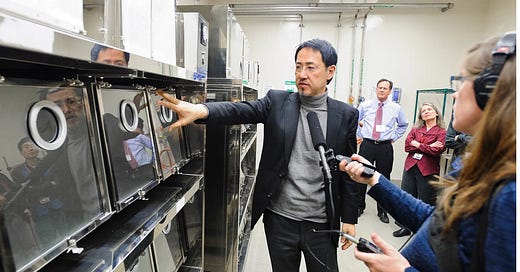A History of H5N1 Lab Accidents
A disturbing report by investigative journalist and author Alison Young
Exactly one year ago, the investigative journalist and author, Alison Young, published a report in USA Today on an accident that occurred on December 9, 2019 at the University of Wisconsin’s Influenza Research Institute.
The accident involved experiments with an H5N1 influenza virus that had been modified through GoF to make it transmissible among ferrets. The research team leader—a renowned virologist named Yoshihiro Kawaoka—had gained international attention (or notoriety) for his controversial GoF research on H5N1. As Alison Young reported:
…in late 2011 the world learned that two scientific teams – one in Wisconsin, led by virologist Yoshihiro Kawaoka, and another in the Netherlands, led by virologist Ron Fouchier – had potentially pushed the virus in that direction. Each of these labs had created H5N1 viruses that had gained the ability to spread through the air between ferrets, the animal model used to study how flu viruses might behave in humans.
The ultimate goal of this work was to help protect the world from future pandemics, and the research was supported with words and funding by two of the most prominent scientists in the United States: Dr. Francis S. Collins, director of the National Institutes of Health, and Dr. Anthony Fauci, director of the NIH’s National Institute of Allergy and Infectious Diseases.
Kawaoka contended it would be “irresponsible not to study” how the virus might evolve in nature. “Some people have argued that the risks of such studies – misuse and accidental release, for example – outweigh the benefits. I counter that H5N1 viruses circulating in nature already pose a threat,” he said at the time.
In Nov. 2013, a needlestick accident happened on Kawaoka’s research team, followed by failure to adhere to the established quarantine rules. Though no human infection resulted from this accident, it was nevertheless alarming. Young’s report continues:
By 2014, there was a growing discomfort at the highest levels of the U.S. government about the risk of an accident with an engineered virus.
Wisconsin’s needlestick incident, which drew questions within NIH but wasn’t publicly known, was soon followed by a series of high-profile accidents at federal labs in 2014 – from safety breaches with anthrax and avian influenza at the CDC to the discovery of forgotten vials of smallpox that had been kept for decades in a storage room on the NIH campus.
In October 2014, citing these federal lab incidents, the White House Office of Science and Technology Policy announced a moratorium on new federal funding for certain gain-of-function research while the risks and benefits of the controversial experiments were studied.
The funding pause remained in place for three years until it was finally lifted in December 2017. But it was only in 2019 that some of the halted experiments were quietly allowed to begin again under a revised federal oversight process, which was criticized for keeping secret the details of the new experiments and the basis for the government approvals.
The second accident on Kawaoka’s team occurred less than a year after GoF experiments were allowed to resume. This time, a lab researcher in training was working with ferrets infected with the GoF-modified H5N1 when his respirator hose was discovered to have detached from his hood, allowing him to breathe the possibly contaminated air in the cabinet. Again the quarantine rules were not properly followed, and nor was the incident promptly reported to the NIH.
Though the accident purportedly did not result in a human infection, it nevertheless raises many questions about the prudence of manipulating the H5N1 virus in a lab in order to make it infectious and transmissible among mammals.
Alison Young’s report prompted me to start reading her book, Pandora's Gamble: Lab Leaks, Pandemics, and a World at Risk, published on April 25, 2023. Young has a long history of researching and reporting on Bio-labs and their checkered past. Most lab manipulation of pathogens is purportedly done to develop vaccines against them in the event that their natural iterations should ever evolve to infect humans, but this rationale is highly questionable if not downright mendacious.
Indeed, on December 18, 2013, the Foundation for Vaccine Research wrote a letter to the European Commission, signed by 56 scientists (including Nobel Laureates) in which they sharply criticized the GoF experiments on H5N1 by virologist, Ron Fouchier.
The 56 scientists vehemently express their opinion that naturally-occurring H5N1 does NOT efficiently transmit to humans and therefore poses little risk to humans.
Far more dangerous, they claim, is the possibility of a lab-modified H5N1 virus escaping from a lab. The scientists refer to the resurgence of H1N1 influenza in 1977 after a 20-year hiatus, most likely after escaping from a lab in the former Soviet Union.






It is not the leaks we need to worry about. It is the WHO releasing it on purpose all over the world to fake a "pandemic" again.
More here; https://truthaddict.substack.com/p/lab-leak-zoonotic-spillover-or-deliberate
Every person engaged in this dangerous and immoral behavior should be defunded now and forever. There is zero reason that this needs to be going on there is no upside benefits and tremendous downside risk as we learned with Covid-19. They will lie and cover up what they did.